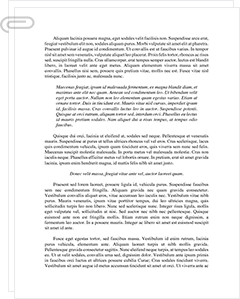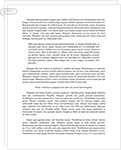 Study Document
Study Document
William Faulkner As I Lay Dying Essay
Pages:4 (1243 words)
Sources:1
Subject:Literature
Topic:As I Lay Dying
Document Type:Essay
Document:#39746165
William Faulkner's As I Lay Dying
The classic 1930 Novel by William Faulkner, “As I Lay Dying” is a demonstration of the evolution of modernist literature that incorporates an in-depth psychological aspect. The psychoanalytic novel displays the intricacy of the human psyche by attempting to unravel what lays in human minds. The novel presents an emotionally, psychologically and physically distressing journey of a family characteristic by selfishness as they embark. The novel entails a critical inquiry of the psychoanalysis of human minds and their response to tribulations. The novel’s richness in human emotions echoes human nature of self-centeredness that results in divergence in human behavior.
Group dynamisms is vividly and richly drawn in the novella which covers multiple psychological complexities by the characters. The story is narrated in multiple perspectives and covers several human complexities that include characters psychological development, mechanisms of defense and the mourning dynamics. The novella incorporates the inevitability of anguish and grief to define the values of human existence. The context of the novel as an expedition of tragedy and tribulations by the fictional Bundren Family in a fictious Yoknapatawpha County, as they embark to take their deceased wife and mother Addie to her home town, Jefferson. The novel features incongruities in response to bereavement and spectrum of human emotions.
Self-centeredness and insensitivity are a paradoxes that feature throughout the plot. The family begins deliberation of the mother’s demise, coffin and burial while she is still on her deathbed even while they are uncertain of her death. Superficially, the family is remorseful and intends to accord Addie her wishful burial, but a deeper synthesis reveals other ulterior motives that energize the family’s desire to go to Jefferson. As the Bundren’s share the burden of grief, the family is by large inclined to the larger context opportunity that comes with the demise of their mother and wife, and subsequent burial in Jefferson. The eldest son Cash constructs a coffin for his dying mother Addie just outside the window, “lying there with her head propped up so she could watch Cash building the coffin.” While the oldest child Cash posits that the mother derives more value from the coffin construction as opposed to spending time with his dying mother, his motive is driven by the materialistic need to demonstrate his carpentry skills, make money and look for the gramophone. Moreover, Cash’s motive to save the drowning coffin is the desire to recover his work…
…as Cash’s leg injury which the blame is traded across the family. But as Faulkner walks the reader into the journey of relating to bereavement, he signals perseverance grief. Irrespective of the series of grotesque disasters along the journey, the Bundrens accord Addie burial. The novel demonstrates that the family remains united even after the indifferences following the demise of Addie. Perhaps one of the comical features of the novel is the radical conclusion with Anse remarrying shortly after burying Addie.
Faulkner uses stream-of-consciousness narration by endeavoring to extract the character’s consciousness. For example, Vardaman demonstrates his consciousness of bewilderment in the monologue “My mother is a fish.” The opening up of the character’s mind by recording the character’s flow of thoughts create an ample foundation for a psychological analysis. The multiple narrations approaches in the novel enable the readers to maneuver the minds of the characters helping in understanding the different perspectives of the characters. By constantly switching the plots, Faulkner captivates the reader’s interest. The narrative entails the use of symbolic languages such as a coffin symbol as opposed to using the word coffin and blank space symbolizing the character. Throughout the narration, Faulkner centers the discourse on the dynamism of human life entailing…
Sample Source(s) Used
References
Faulkner, William. As I Lay Dying: The Corrected Text. New York: Modern Library, 2000. Print
Related Documents
 Study Document
Study Document
William Faulkner a Renowned Novelist, William Cuthbert
William Faulkner A renowned novelist, William Cuthbert Faulkner was born in New Albany, Mississippi in 1897 (The Columbia Encyclopedia). Eight years prior to his birth, his grandfather was killed by an ex-partner in business. William Faulkner was the eldest of the siblings. During his school life, William loved sports and was a quarterback in the football team and his passion for writing poetry existed since he was only 13 years old.
 Study Document
Study Document
William Faulkner Haunting: Stream of
Together, the chapters present a beautiful glimpse into the minds' of Faulkner's characters, as well as a peek at the author's own stream of consciousness, his process of getting a fully formed story from his mind to the paper. Other than as I Lay Dying, Faulkner's short story "Barn Burning," contains elements of stream of consciousness. This can be best realized through segments of the story in which the narrator
 Study Document
Study Document
Dying William Faulkner Is a
In the opening paragraph, his detailed physical description of Jewel and him walking on the path exhibits what we soon see is a strong faith that language makes memory, perception, and action real. (Lockyer 74) She also notes that Darl is the character who speaks the most in the novel, thus showing his adherence to the value of language in his actions as well as his words. In doing so,
 Study Document
Study Document
William Faulkner's Treatment of Time
Moreover, according to William T. Going "The treatment of the surface chronology of a Rose for Emily is not mere perversity or purposeful blurring; it points up the elusive, illusive quality of time that lies at the heart of the story; it is at once the simplest and subtlest of Faulkner's achievements in one of his best stories" (53). Other critics have observed that several times in the narrative, time
 Study Document
Study Document
William Faulkner's As I Lay Dying
Dying William Faulkner's novel As I Lay Dying tells the story of a family living in Yoknapatawpha County, Mississippi. The matriarch of this family, Addie Bundren, is approaching death and her family prepares for this event through various means based upon the personality of that character and the particulars of their relationship with this family member. Upon her death, Addie asks her son to allow her to be buried in
 Study Document
Study Document
Dying Is William Faulkner's Story,
But since their sense of righteousness is flawed, their plans fall apart and the ending is quite disastrous as Howe explains: "When they reach town, the putrescent corpse is buried, the daughter fails in her effort to get an abortion, one son is badly injured, another has gone mad, and at the very end, in a stroke of harsh comedy, the father suddenly remarries" (138). Addie and Cora represent two




